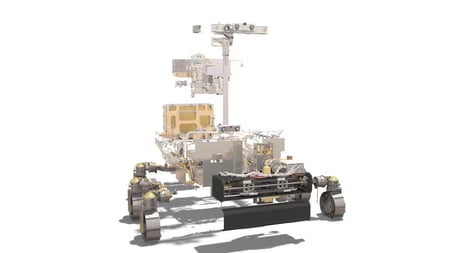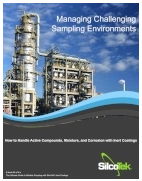
SilcoTek is on board the ExoMars 2022 mission. Let's find out how our durable and inert coatings contribute to the mission.
SilcoTek is Going to Mars Again!
We're going to Mars! We'll not "us" but our coatings sure are going. Let's discuss why the ExoMars mission chose SilcoTek® Coatings for their analytical systems.
|
In this blog post you will learn:
- How SilcoTek® coatings are used in analytical systems for space exploration.
- What analytical components are coated with SilcoNert® to improve test sensitivity and durability.
- How SilcoTek coatings have contributed to previous space missions.
|
About the ExoMars 2022 Mission and How SilcoTek Coatings are Used
I was reading about the next Mars exploration mission in Chemical & Engineering News, called ExoMars 2022. It is a joint European Space Agency / Russia mission where they will explore a region of Mars rich in clay deposits that may have been left behind by an ancient river delta. The rover, called the Rosalind Franklin, will drill down 2m to collect samples that will be analyzed in a variety of ways including Gas Chromatography (GC) and Mass Spectrometry (MS).
 **
**
The GC/MS will be part of an instrument package called the MOMA, or Mars Organic Molecule Analyzer. It will be equipped with three Restek® Mxt-based GC columns, which were deactivated with our SilcoNert® 2000 process!
MOMA utilizes Mxt SilcoNert coated columns because Mxt columns offer superior durability while providing high quality analytical test results. An inert deactivation surface, like SilcoNert 2000 helps the normally reactive steel column surface to achieve superior peak resolution, high peak quality, excellent analytical sensitivity and peak separation. It can be difficult to find inert coatings for high temperature applications, low temperature durability, and high shock environments. That's why our coatings stand out in space applications.
The MOMA will also have a chemistry lab of sorts, which will perform reactions with chemicals found on Mars to improve detection (a process called derivatization). The stainless steel capsules, purchased from Restek, were treated with our “Silcosteel” coating, now called SilcoNert® 1000, to keep the stored chemicals stable throughout their time in space and on Mars.
The links below talk about the mission and the detection systems that uses our coating. The Exomars Rover was scheduled to launch July 2020, but has been postponed until 9/20/2022. So we'll have to wait a while until launch. And no kids we're not there yet!
https://ssed.gsfc.nasa.gov/IPM/IPM2012/PDF/Revised_Orals/Steineinger-1116.pdf
https://www.hou.usra.edu/meetings/lpsc2015/pdf/2680.pdf
https://www.liebertpub.com/doi/10.1089/ast.2016.1551
Previous Space Missions That Used SilcoTek® Coatings
The ExoMars mission joins a long list of missions that used our CVD coatings for improved inertness and sampling reliability in space exploration. Recent missions that used our coatings include:
 The European Space Agency mission, Rosetta. Rosetta's mission successfully intercepted, monitored, and analyzed the comet 67P/Churyumov-Gerasimenko . SilcoNert® 2000 coated sampling instrumentation flow path assured a reliable analysis of the comet nucleus.**
The European Space Agency mission, Rosetta. Rosetta's mission successfully intercepted, monitored, and analyzed the comet 67P/Churyumov-Gerasimenko . SilcoNert® 2000 coated sampling instrumentation flow path assured a reliable analysis of the comet nucleus.**
 Mars Rover Curiosity. Curiosity landed on Mars at Gale Crater in 2012. Since landing Curiosity valiantly fulfilled it's mission as NASA states:*
Mars Rover Curiosity. Curiosity landed on Mars at Gale Crater in 2012. Since landing Curiosity valiantly fulfilled it's mission as NASA states:*
"Curiosity set out to answer the question: Did Mars ever have the right environmental conditions to support small life forms called microbes? Early in its mission, Curiosity's scientific tools found chemical and mineral evidence of past habitable environments on Mars. It continues to explore the rock record from a time when Mars could have been home to microbial life."
 Cassini space craft. Cassini explored the outer reaches to Saturn. In 2017 Cassini flew through Saturn's rings and crashed on the surface after 2 decades of space exploration. All the time gathering data and making great science.*
Cassini space craft. Cassini explored the outer reaches to Saturn. In 2017 Cassini flew through Saturn's rings and crashed on the surface after 2 decades of space exploration. All the time gathering data and making great science.*
According to the Grand Finale web page, the probe continued to gather important information right to the end.
-
- The spacecraft made detailed maps of Saturn's gravity and magnetic fields, revealing how the planet is arranged internally, and possibly helping to solve the irksome mystery of just how fast Saturn is rotating.
- The final dives will vastly improved our knowledge of how much material is in the rings, bringing us closer to understanding their origins.
- Cassini's particle detectors sampled icy ring particles being funneled into the atmosphere by Saturn's magnetic field.
- Its cameras took amazing, ultra-close images of Saturn's rings and clouds.
 Iodine thruster experiments. NASA tested our coatings under extreme halogen plasma conditions found on their latest state-of-art iodine thrusters.*
Iodine thruster experiments. NASA tested our coatings under extreme halogen plasma conditions found on their latest state-of-art iodine thrusters.*
To learn more about how our coatings can improve sampling in challenging environments, get our e-book.

Why Use Our Coatings?
Why are SilcoTek coatings used in sampling systems? Because no other coating has both the inertness and durability to withstand the harsh environment of space and assure samples taken don't react with the instrument flow path.
/Inertness%20Response.png?width=345&name=Inertness%20Response.png)
SilcoTek® coatings like Dursan® and SilcoNert® beat other industry deactivations for durability, inertness response and corrosion resistance.
To learn more about how our coating can improve your products, contact our Technical Service Team. To stay current with the latest in coating technology subscribe to our emails and blog or follow us on LinkedIn.

* Image credit: NASA, https://mars.nasa.gov/
** Image credit: European Space Agency

 **
** The European Space Agency mission, Rosetta. Rosetta's mission successfully intercepted, monitored, and analyzed the comet 67P/Churyumov-Gerasimenko . SilcoNert
The European Space Agency mission, Rosetta. Rosetta's mission successfully intercepted, monitored, and analyzed the comet 67P/Churyumov-Gerasimenko . SilcoNert Mars Rover Curiosity. Curiosity landed on Mars at Gale Crater in 2012. Since landing Curiosity valiantly fulfilled it's mission as NASA states:*
Mars Rover Curiosity. Curiosity landed on Mars at Gale Crater in 2012. Since landing Curiosity valiantly fulfilled it's mission as NASA states:* Cassini space craft. Cassini explored the outer reaches to Saturn. In 2017 Cassini flew through Saturn's rings and crashed on the surface after 2 decades of space exploration. All the time gathering data and making great science.*
Cassini space craft. Cassini explored the outer reaches to Saturn. In 2017 Cassini flew through Saturn's rings and crashed on the surface after 2 decades of space exploration. All the time gathering data and making great science.*  Iodine thruster experiments. NASA tested our coatings under extreme halogen plasma conditions found on their latest state-of-art iodine thrusters.*
Iodine thruster experiments. NASA tested our coatings under extreme halogen plasma conditions found on their latest state-of-art iodine thrusters.*
/Inertness%20Response.png?width=345&name=Inertness%20Response.png)

